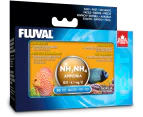Fluval Ammonia Test Kit (50 tests) (A-7869)

Fluval Ammonia Test Kit (50 tests)
- Fast and accurate liquid test to measure ammonia levels in your aquarium
- Essential for optimal water conditions
- Store in a cool, dry place
Accurately measure ammonia levels in your freshwater or saltwater aquarium with the Fluval Ammonia Test Kit. Ammonia is produced when uneaten food and waste decompose. If the uneaten food and waste are left to accumulate in your aquarium, it creates a highly stressful and toxic environment for your fish. In order to find out if you have a buildup of ammonia in your aquarium, you need to test weekly. 50 tests per kit. For freshwater and saltwater.
Kit includes: 2 x NH3 (15 ml)
1 x NH3 (10 ml)
1 x Pipette
1 x Glass test tube
Instruction booklet
More Information WHY ANALYZE AMMONIA?
The presence of ammonia in aquariums can be a source of many problems. In fact, ammonia should not be measurable. Levels above 1.2 mg/L in very alkaline water (above 8.0 pH) are toxic to aquatic organisms.
HOW IS AMMONIA PRODUCED? Ammonia is produced by fish respiration and the decay of waste products in the aquarium. The decomposition of organic matter such as excess food, dead leaves and fish also produces ammonia. Ammonia can be present in two forms. Ammonia NH, which is a toxic gas, and ionic ammonium NH +, which is much less deadly. The pH of the water is the major factor that determines the ratio of NH and NH +. When the pH is high, the ammonia is in its toxic form. Toxic ammonia will increase exponentially with increasing pH levels and temperature. A pH value of over 8.0 causes a corresponding rapid increase in the toxic ammonia component. It is recommended to test the pH of water to determine whether toxic ammonia is present. Testing on at least a weekly basis will help to spot a problem before it reaches a dangerous level.
HOW DOES THE TEST WORK? 1. Take a sample of the water to be tested with the pipette and use it to fill a clean test tube to the 5 mL line.
2. Add 7 drops of Reagent #1 into the test tube. Insert cap. Hold in place with finger and shake well to mix. ATTENTION! ALWAYS USE THE CAP. AVOID SKIN CONTACT.
3. Add 7 drops of Reagent #2 into the test tube. Insert cap. Hold in place with finger and shake well to mix.
4. Add 7 drops of Reagent #3* into the test tube. Insert cap. Hold in place with finger and shake well to mix.
5. Wait 20 minutes for color to develop and match the test color to the closest color on the chart. For best results, hold the test tube flat against the paper and read with a light source behind you.
6. After use, rinse the tube with fresh tap water to ensure it is clean for next use.
*IT IS VERY IMPORTANT TO PROTECT THIS REAGENT FROM LIGHT. KEEP BOTTLE CLOSED AND IN THE BOX.
EVALUATING THE RESULTS Normally, in an established aquarium, the test should not detect ammonia. However, under normal start-up conditions, it is common to see high levels of ammonia. The bacterial strains responsible for nitrification (the transformation of ammonia to nitrite and finally to nitrate) are not available in a new aquarium setup. It is strongly recommended to use a Biological Aquarium Supplement in order to accelerate the bacterial growth and nitrification process.
COLOR CHART RESULTS <1.2 mg/L
If the result from the color chart indicates that the ammonia level is below 1.2 mg/L, continue to add a biological supplement on its regular dosage schedule.
>1.2 mg/L
If the result from the color chart indicates that the ammonia level is above 1.2 mg/L, you will need to obtain a pH test kit to determine the pH level of the water. Once you have the results of your ammonia test and your pH test, you can use the number chart to determine whether toxic ammonia is present.
NUMBER CHART RESULTS RED ZONE
If the result falls in the Red Zone, this indicates that there is a high presence of toxic ammonia in the water. Immediately perform a 20% water change. However, make sure not to raise the pH!
Use Tap Water Conditioner in the replacement water to reduce fish stress (patented process) by removing chlorine and chloramine, and neutralizing heavy metals. If in doubt, test dechlorinated municipal tap water for its ammonia concentration before performing the water change. Add replacement water slowly in order to avoid fluctuations in other water characteristics. Add a double dose of Biological Supplement to activate and supplement the biological filter.
YELLOW ZONE
If the result falls in the Yellow Zone, this is considered the "critical" zone. Add a double dose of Biological Supplement and test again in 24 hours.
GREEN ZONE
If the result falls in the Green Zone, check your ammonia level regularly and continue to use Biological Supplement on a regular basis.
‘Don’t Pay’ is the recommended retail price provided by the supplier or obtained from the manufacturer, or is the recently advertised price for the same product on a different or competing online platform or store. Catch may not have previously sold the product at the ‘Don’t Pay’ price.
